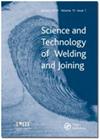金属薄板超声点焊的数值分析综述
IF 3.7
3区 材料科学
Q2 MATERIALS SCIENCE, MULTIDISCIPLINARY
Science and Technology of Welding and Joining
Pub Date : 2023-09-20
DOI:10.1080/13621718.2023.2260625
引用次数: 0
摘要
摘要超声点焊作为一种连接金属薄板的方法,近年来受到了广泛的关注。数值模拟对于理解这一过程的原理,提高超声点焊接头的质量具有重要的作用。本文旨在总结超声点焊有限元模型中的关键参数,包括摩擦系数、热场、声热软化、网格划分和边界条件。此外,还详细介绍了与模拟结果相关的焊接界面温度、应力分布、塑性应变、金属间化合物、宏观组织、动态再结晶和界面扩散等方面的研究现状。此外,本文还讨论了数值模拟存在的挑战和发展趋势。本文由国家自然科学基金(51905171,51975406)资助,作者感谢材料科学与工程学院客座教授的专项资金和设备支持。a . a . Nazarov得到了俄罗斯科学基金会22-19-00617号基金的资助。披露声明作者未报告潜在的利益冲突。本研究由国家自然科学基金资助[资助号:51905171;51975406);俄罗斯科学基金会[资助号22-19-00617]。本文章由计算机程序翻译,如有差异,请以英文原文为准。
Numerical analysis of ultrasonic spot welding of metal sheets: a review
AbstractUltrasonic spot welding has recently garnered significant attention as a method for joining metal sheets. Numerical simulation plays an important role in understanding the principles of this process and improving the quality of the ultrasonic spot welded joint. This paper aims to summarises the critical parameters in the finite element model of ultrasonic spot welding, including the friction coefficient, thermal field, acoustic and thermal softening, meshing and boundary conditions. Additionally, it provides a detailed review of the research status related to the simulation results, such as welding interface temperature, stress distribution, plastic strain, intermetallic compounds, macrostructure, dynamic recrystallisation and interfacial diffusion. Furthermore, this paper discusses the remaining challenges and the development trend of the numerical simulation.KEYWORDS: Ultrasonic spot weldingfriction coefficientstress distributionthermal fieldacoustic and thermal softening AcknowledgementsThis work was funded by the National Natural Science Foundation of China (No. 51905171, 51975406), and the authors thank for the special funding and equipment support of the visiting professor at the School of Materials Science and Engineering. A. A. Nazarov was supported by a grant # 22-19-00617 from the Russian Science Foundation.Disclosure statementNo potential conflict of interest was reported by the author(s).Additional informationFundingThis work was supported by the National Natural Science Foundation of China [grant number 51905171; 51975406]; the Russian Science Foundation [grant number 22-19-00617].
求助全文
通过发布文献求助,成功后即可免费获取论文全文。
去求助
来源期刊

Science and Technology of Welding and Joining
工程技术-材料科学:综合
CiteScore
6.10
自引率
12.10%
发文量
79
审稿时长
1.7 months
期刊介绍:
Science and Technology of Welding and Joining is an international peer-reviewed journal covering both the basic science and applied technology of welding and joining.
Its comprehensive scope encompasses all welding and joining techniques (brazing, soldering, mechanical joining, etc.) and aspects such as characterisation of heat sources, mathematical modelling of transport phenomena, weld pool solidification, phase transformations in weldments, microstructure-property relationships, welding processes, weld sensing, control and automation, neural network applications, and joining of advanced materials, including plastics and composites.
 求助内容:
求助内容: 应助结果提醒方式:
应助结果提醒方式:


